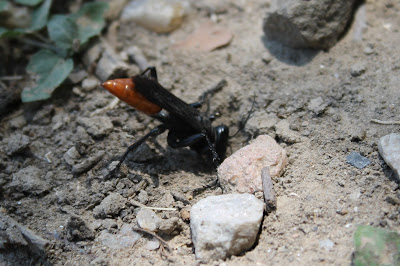 |
| Prionyx |
This wasp was observed nervously digging in the dry dust of the road up near the house.
Here's a well-organized and illustrated web site that features prionyx with a focus on the parkeri species, briefly described below. I'm not saying that our wasp is prionyx parkeri, but it comes pretty close if it isn't.
https://cdri.org/fieldguides/wasps/taxonomy/prionyx-parkeri.html
"Prionyx [parkeri] is a thread-waisted wasp with the abdomen attached to the thorax by a slender thread. The head and thorax are black and the abdomen reddish-orange. She is similar to Sphex texana. Both are thread-waisted and have reddish-orange abdomens, but Sphex texana’s abdomen is more elongate, while Prionyx’s abdomen is bulbous, and the tip comes to a sharper point.
Nesting habit and prey : Prionyx is a solitary, ground-nesting wasp. She excavates a nest cavity in sandy soil, then hunts for her grasshopper prey. She stings the grasshopper, paralyzing, but not killing it, then drags it back to the nest and pushes it into the brood cell. She loads several grasshoppers into the nest, lays one egg on one grasshopper, then seals the nest, and goes off to build and provision another nest.
Prionyx as pollinator : Prionyx collects grasshoppers to provision the nest for her young, but she sips nectar for her own sustenance. She has a short tongue and so she nectars at plants with open, shallow flowers including Texas kidneywood, mortonia, soapberry, and various composites. Although she has a short tongue and cannot reach into tubular flowers, she has been observed 'robbing' nectar by cutting a tiny hole in the flower and sipping nectar through it. This is known as robbing because she is not doing the work of carrying pollen in exchange for the reward of nectar."
And for the flowers that were in bloom May 2 beside the house:

